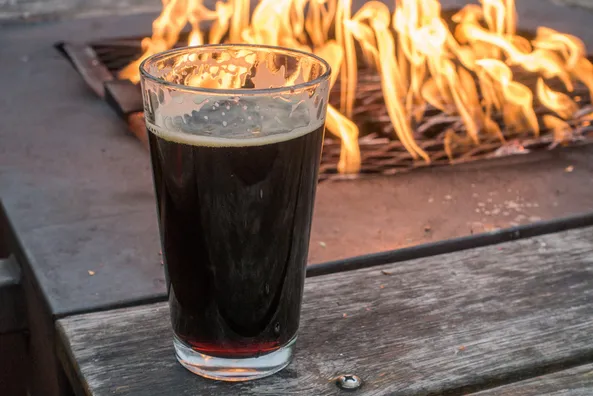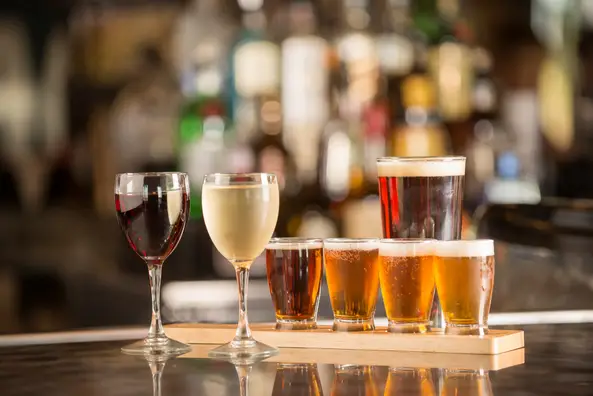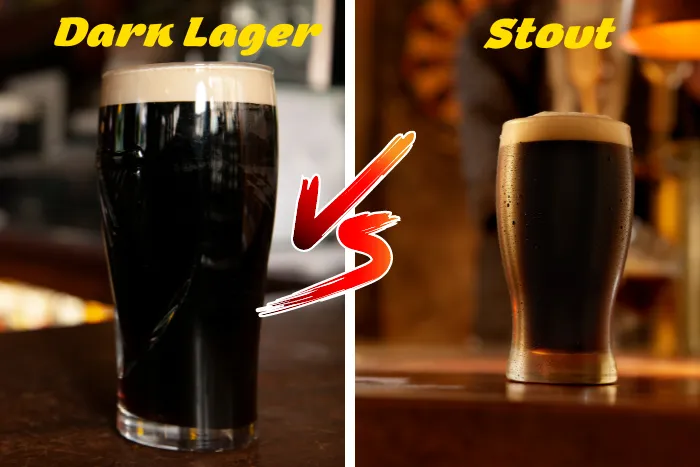Regarding beer, two of the most widely consumed varieties are dark lagers and stouts – each with unique characteristics. Even though they look similar, these two beers are not the same. They come from different places, use different ingredients during fermentation and brewing, have different tastes and textures, and have different amounts of alcohol. So what exactly is the difference between a dark lager vs a stout? Let’s take a closer look at each type of beer to find out. We’ll give you a list of some great dark lagers and stouts to try and talk about the pros and cons of each so you can choose your next beer with confidence.
Table of Contents:
- Dark Lager Beer
- Stout Beer
- Popular Dark Lager Beers to Try
- Popular Stout Beers to Try
- Pros and Cons of Dark Lager Beers
- Pros and Cons of Stout Beers
- FAQs in Relation to Dark Lager vs Stout
- Conclusion
Dark Lager Beer

Dark lager beer has been made with malted barley, hops, yeast, and water for centuries. It is typically made from malted barley, hops, yeast, and water. The fermentation process occurs at cooler temperatures than other types of beer, giving it its characteristic deep color and smooth flavor profile. They have between 4 and 6% alcohol and 10 and 25 International Bitterness Units (IBU).
Dark Lager: Origins and History
Dark lager originated in Bavaria during the 16th century, when brewers used cold storage techniques to store their beers for longer periods. Brewers developed a novel kind of dark brew that was more full-bodied in flavor than the paler ales and pilsners, thanks to using cold storage techniques for longer preservation.
In the 1800s, German immigrants brought this cold storage method to North America. It made it possible for dark lager to become popular worldwide. Today, dark lagers are popular among craft breweries as well as traditional breweries all over the world.
Dark Lager: Brewing Process
Mashing malted barley with hot water to draw out the sugars is the starting point for crafting a dark lager. Hops are added for bitterness and aroma, while yeast ferments these sugars into alcohol over several weeks at cool temperatures (around 50°F). During this process, proteins settle out, creating a clear liquid ready to be bottled or kegged after filtering one last time before serving or packaging up for sale.
The result is a well-rounded yet surprisingly smooth drink that tantalizes the nose with roasted maltiness, caresses the tongue with chocolatey sweetness, and finishes with assertive hop bitterness. Its low carbonation levels provide a velvety mouthfeel compared to other more highly effervescent beers such as pale ales or IPAs.
Dark Lager: Color, Alcohol Content, and IBU
As far as appearance goes, dark lagers range from reddish brown hues up through nearly black colors depending on how long they were aged before bottling or kegging, usually having an ABV between 4% and 6% accompanied by moderate IBUs falling somewhere within the 10–25 range respectively.
Lastly, dark lagers are relatively low-calorie beverages, containing only 100–150 calories per 12-ounce serving, making them ideal options for those looking for something flavorful without packing too many extra calories onto their waistlines.
Dark lager beer is a light-bodied, smooth, refreshing beverage with a slight sweetness. Stout beer stands out from other brews due to its distinct qualities, such as its full-bodied texture and robust flavor.
Stout Beer
History
Stout beer is a style of dark, top-fermented beer that comes from the UK. It is dark brown to black and tastes very roasted because malted barley was used to make it. The alcohol by volume (ABV) of stouts is higher than that of other types of beer. Most stout beers are made by adding yeast to the cooled wort and letting it ferment for a few days before putting it in bottles or kegs.
In the late 1700s, brewers started making beer with roasted malt, which led to stout beer. By the middle of the 1800s, stout was popular in Britain and Ireland, especially in London, where it was called “porter” because it was often drunk by people who carried goods on horseback or foot.
Today, the varied and beloved stout style of craft beer continues to be widely enjoyed, with offerings ranging from oatmeal stouts, imperials, milk-based varieties, coffee-infused concoctions, and beyond.
Stout Ingredients and Fermentation Process
Traditional stout recipes use pale ale malt and darker grains like chocolate or black patent malt. It gives stouts their dark color and strong flavor. Hops may also be added during the boiling stage for bitterness balance, but are optional for traditional recipes since they are already quite bitter due to the high levels of roasted grain used in production. After boiling, yeast is added to cool the wort before it ferments over several days at temperatures between 60-70°F (15-21°C).
Flavor Profile of Stout
Stouts are known for their strong roasted grain flavor, ranging from subtle coffee notes to burnt toast flavors, depending on how roasted the grains are. They also often have sweet caramel notes from the sugars after fermentation.
On the palate, stouts tend to be full-bodied yet velvety smooth with low carbonation levels that prevent any harshness when gulped down quickly – making them an ideal sipping beer if you’re looking for something flavorful but not too intense.
Color and ABV of Stout
When you pour a stout into your glassware, expect it to look like motor oil: deep brown or black with hints of redness depending on the light that passes through. The ABV ranges from 4% to 8%, and IBUs generally fall between 20 and 50, making this an ideal session beer without sacrificing flavor complexity.
Popular Dark Lager Beers
Regarding dark lager beers, various options can satisfy any beer lover’s palate. From the smooth, malty flavors of Vienna Lagers to the roasty notes in Schwarzbiers and Dunkels, there is something for everyone. Here are some popular dark lager beers you should try:
1. Vienna Lager
Originating in Vienna, Austria, the Vienna Lager has become a widely-enjoyed dark lager. It features a deep amber color, a sweet maltiness on the nose, and a balanced flavor profile with a subtle bitterness. Examples include Negra Modelo from Mexico or Stiegl Goldbrau from Austria.
2. Schwarzbier
This German-style lager, called “black beer,” has a light body and tastes like roasted malt. The color ranges from deep brown to black, depending on how much-roasted barley is used during brewing. Some notable examples include Köstritzer Schwarzbier and Spaten Optimator Doppelbock, both hailing from Germany.
3. Dunkel
A traditional Bavarian-style dark lager that features rich maltiness and notes of caramelized sugar or chocolate due to Munich malts being used during the brewing process. It also typically has low hop bitterness, which makes it very drinkable even at higher ABV levels (5%–6%). Popular brands include Paulaner Original Münchner Dunkel or Hofbrauhaus München Dunkel, both brewed in Germany according to Reinheitsgebot law (German Beer Purity Law).
4. Altbier:
Originating in Düsseldorf, Germany, this style combines old world tradition with modern techniques, resulting in an amber colored ale-like beer with robust malty sweetness balanced by moderate hop bitterness, making it perfect for any occasion. Notable brands include Uerige Altbier Sticke from Düsseldorf or Fürstenberg Premium Altbier, also hailing from Germany.
Dark lagers are an ideal entryway into craft beer, with something to satisfy every taste. With their pros and cons in mind, let’s explore the world of stout beers next.
Popular Stout Beers

When it comes to stouts, Guinness is the undisputed king. Since 1759, the Irish brewery has produced this dark, creamy beer, a favorite among craft beer drinkers worldwide.
Other examples of this style include Irish stout, an English stout, American stout, Oatmeal stout, Milk stout, and Oyster Stout. Popular brands like Black Rock Irish Stout, O’hara’s Irish Stout, or Porterhouse Oyster Stout are great choices for those looking for an authentic experience.
Meanwhile, in America, you can find Deschutes Obsidian Stout Firestone Walker Velvet Merlin or Avery Out Of Bounds as excellent options to make your taste buds dance with joy. And if you want something more exotic, try Old Rasputin from Russia or Dragonhead from England.
Pros and Cons of Dark Lager Beers
Dark lager beers are a popular choice for many beer drinkers. Dark lagers may be less renowned or appreciated, yet they provide a distinct and alluring flavor that amateur and knowledgeable beer fans can relish. Weighing up the benefits and drawbacks of dark lager beers is essential before committing to a purchase.
Pros of Dark Lager Beers
One major benefit of drinking dark lagers is their smoothness. Dark lagers tend to have a much smoother taste than other types of beer, which makes them easier to drink and enjoy without being overwhelmed by intense flavors or bitterness.
This makes them great for those who don’t typically like bitter beers but still want something more complex than light-colored brews. Also, dark lagers usually have less alcohol than other types of beer because they have fewer hops. You can enjoy multiple drinks in one sitting without getting too intoxicated too quickly.
Another advantage is the range of flavors available in dark lager beers. Brewers often mix and match ingredients, like roasted malts, chocolate malt extract, coffee beans, or even fruits like cherries or plums, to make unique flavors that set their dark lagers apart. The result is an array of diverse tastes ranging from sweet and malty to smoky and earthy – all within one type of beverage.
Cons of Dark Lager Beers
Only some enjoy the intense flavors associated with dark lagers, as some may find them too strong for their taste. Furthermore, commercial breweries often employ adjunct grains when producing their darker varieties. It could lead to off-flavors if not properly balanced during fermentation – resulting in overly sweetened beers that fail to satisfy connoisseurs. Finally, prices for dark lager beers tend to be slightly higher due to the additional production costs associated with specialty malts used during brewing.
In conclusion, dark lager beers may be worth a try if you are looking for something light yet complex enough for experienced palates or curious about trying something new. With its smooth texture and a wide variety of flavorful options available today, there is sure to be something that suits your taste buds perfectly.
Pros and Cons of Stout Beers
Stout beers are popular beers that have been around for centuries. Stout beers offer a distinct flavor and texture and potential health benefits; however, they may also come with some drawbacks. But they also have some drawbacks that should be considered before drinking them regularly.
Pros of Stout Beers
One of the best things about stout beers is that they have a lot of different flavors and are very complex. Roasted malts give stouts a rich, bittersweet flavor. They’re perfect for pairing with steak or chocolate desserts or drinking alone when you want something strong and flavorful.
Stouts boast a higher alcohol content than other types of beer, typically ranging from 4-12% ABV (alcohol by volume). It means it will take fewer drinks to feel its effects than lighter varieties like lagers or pilsners. If you need a pick-me-up after a long day, it has more calories per ounce than most other beers.
Cons of Stout Beers
Stouts typically have a lower IBU rating than IPAs or double IPAs, making them less bitter. Stouts have fewer International Bitterness Units (IBUs) than IPAs and double IPAs, which can have over 100 IBUs. If consumed frequently without countermeasures like snacking on healthy foods between drinks, these brews’ higher sugar content could raise blood glucose levels. Lastly, these brews may turn off those who don’t appreciate bold flavors despite their popularity among beer enthusiasts.
Even though stout beers have a lot of pros, like great flavors and high alcohol content, they also have some cons, like lower IBU ratings and the possibility that blood sugar levels will rise if drunk too often without moderation. Thus, before trying stouts, one must know their pros and cons.
FAQs in Relation to Dark Lager vs Stout
What is the difference between dark lager and stout?
Dark lager is smooth, malty, and light to medium in color. It has low hop bitterness and alcohol content. On the other hand, stout is a dark-colored beer made using roasted malt or barley, hops, water and yeast. Stouts are usually full-bodied with notes of coffee or chocolate flavors as well as some fruity tones. They tend to have higher alcohol content than lagers but lower hop bitterness.
Is stout better than lager?
It is difficult to determine a definitive preference between stout and lager, as it ultimately comes down to individual taste. Stouts are known for their fuller flavor, due to the greater alcohol content and roasted grain ingredients. Lagers are generally lighter in body and color, with a crisper finish that can be refreshing on hot days. Both styles have distinct qualities that suit different tastes, so there’s no right or wrong choice.
Is dark beer the same as stout?
No, dark beer and stout are not the same. Roasted malts produce dark beers with amber or brown hues. Stouts, which are dark beers made with roasted barley, are richer and have coffee and chocolate flavors. While these two categories overlap, stouts have a stronger flavor than other dark beers.
What makes a dark lager?
Roasted malts give dark lagers their dark color, chocolate and coffee flavors, and sweetness. Dark lagers have chocolate, coffee, and malty sweetness. Dark lagers often boast higher alcohol content than other beers, thanks to a longer fermentation period. It offer a full-bodied, smooth taste that appeals to those who prefer intense flavor profiles.
Conclusion
In the end, dark lager and stout are two different kinds of beer with different tastes. Dark lagers are lighter in color and have less intense flavors than stouts. They also generally contain lower levels of alcohol content compared to their stout counterparts. On the other hand, stouts tend to have stronger flavors and more bitterness because their IBU rating is higher. No matter your preference, whether it’s the creamy notes of a dark lager or the strong flavors from a stout, there is no wrong decision when deciding between these two distinct beer varieties.
With the help of our expert beer reviews and tips, you can find the best dark lager or stout for your tastes. Today, find the best subscription service, equipment, and recipes to make your craft brews!
Also See: Comparing Dark Ale Vs Stout: A Comprehensive Guide

